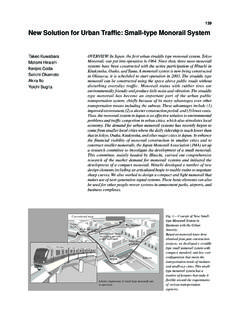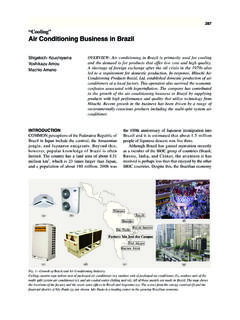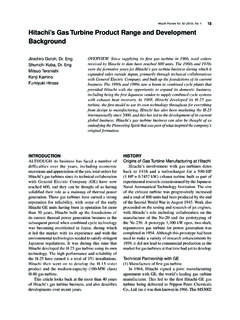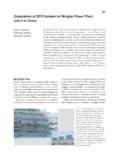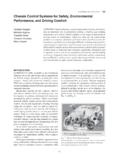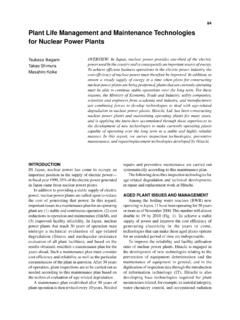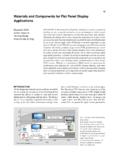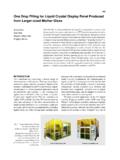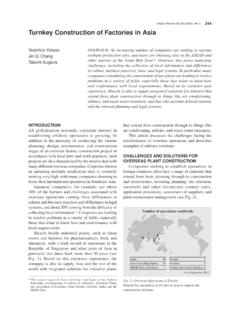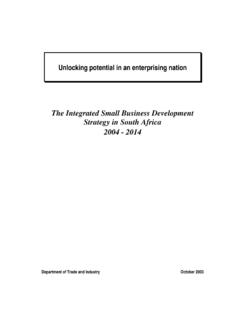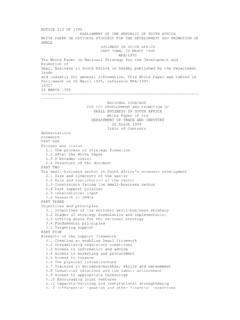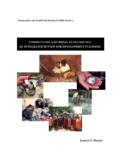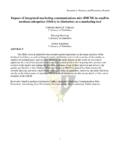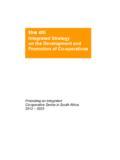Transcription of Global Business Development of Hitachi Automotive Systems
1 Hitachi Review Vol. 63 (2014), No. 2 66 - 11 - Global Business Development of Hitachi Automotive SystemsYuzo Kadomukai, Dr. ItakuraTakayoshi KomaiJumpei KomatsuAUTOMOTIVE system Business ENVIRONMENTTHE Global vehicle market is expected to maintain strong annual growth of by volume over the period between 2012 and 2020 (see Fig. 1).By region, annual growth in mature markets is predicted to be accompanied by annual growth of in emerging regions, which are expected to account for 58% of Global production by volume in 2020, up from 48% in 2012 and a forecast of 53% in vehicle segments, the proportion of small vehicles is expected to rise from 62% in 2012 to 65% in 2020.
2 By power train, production of electric drive Systems such as hybrid electric vehicles (HEVs) or electric vehicles (EVs) is expected to increase by annually between 2012 and 2020. Despite this, growth in production of vehicles with conventional petrol or diesel internal combustion engines (ICEs) is also expected to grow strongly, and to still account for 94% of total volume by , environmental regulations, safety testing standards, and other regulatory requirements are being strengthened around the world (see Fig. 2). Stronger combustion and exhaust gas regulations are also being adopted for things like carbon dioxide (CO2), nitrogen oxides (NOx), and particulates, with standards in emerging regions expected to rise to levels similar to those in mature markets.
3 At the same time, rules on vehicle safety testing are being tightened and extended to include pedestrian safety as well as vehicle collision these developments, Hitachi operates globally to meet the needs of vehicle manufacturers who are grappling with environmental and safety technology while also seeking to expand their businesses in growing emerging OF Hitachi Automotive SYSTEMSIn a push to become a major Global player in the Automotive system Business , Hitachi Automotive 52%47%53%9242% growth2012A2020 Annual growth58%105( 1,000,000 vehicles)EmergingregionmarketsMaturemark etsSmall70% of small vehicle sales are in emerging economies large48%82201220152020(Year)(Year)(Year) 62%64%36%9265%35%105By regionBy vehicle segmentsBy power train38%8220122015202098%97%3%9294%6%105 2%82201220152020 Source: Figures produced by Hitachi Automotive Systems from data published by IHS : electric vehicle ICE: internal combustion engineFig.
4 1 Forecast Global Vehicle Production 2012 market and vehicle type, strong growth in production volumes is anticipated in emerging regions (including Asia and South America) and small vehicles. By power train, while production of electric vehicles is expected to increase signifi cantly, it is forecast that vehicles with ICEs will still account for 94% of production in Global Business Development of Hitachi Automotive Systems - 12 - Systems , Ltd. is transforming itself into an organization with a Global market focus in which Business decisions and operations take place closer to the market. Its Business operations cover a wide range, including environmental products, such as engine management Systems and hybrid Systems ; safety products, such as stereo cameras, suspensions, and brakes; information products, such as the car navigation Systems from Clarion Co.
5 , Ltd.; and industrial machinery (see Fig. 3).Since the Global fi nancial crisis that struck in the fall of 2008, Hitachi Automotive Systems , Ltd. has undergone a Business restructuring that has included the rationalization of fi xed costs as it sought to enhance its Monozukuri manufacturing capabilities and build an organization based on Global earnings management. These efforts have been underpinned by the basic policies of a self-driven, earnings-focused management approach; faster decision making; a shift to a Business structure suitable for Global markets; and new integrated management of the company that transcends the boundaries within the organization.
6 In addition to the adoption of a regional headquarters structure for overseas operations in FY2011, the company has also accelerated its shift to Global operations through initiatives such as expanding its activities in emerging economies, establishing a Global sales organization, strengthening research and Development , standardizing manufacturing practices globally, implementing operational reforms, and developing regulationsSafety evaluation2005(gCO2/km)(Normalized to NEDC)501001502002010 JapanJapanEuropeUSAR egionJNCAPV ehicle safety testingPedestrian safety testingEuro-NCAPNCAP/IIHSE valuateinstitutionCollision warning/lane departure warningCollision avoidance/mitigate damageCollision avoidance/mitigate damageExcessive speed warningLane departure warningLane departure warningPedestrian collision avoidancePedestrian collision avoidanceNighttime pedes-trian collision avoidanceCollision avoidance(low, medium, and high speed)Mitigate damage2012 2013 2014 2015 20162017A2020 (Year)USAE uropeChinaNew long-termregulationsPost new long-term regulationsTier2 Tier3 Euro4 Euro5 Euro6 Euro7 Euro3200520102015(Year)(Year)
7 2020 Euro4 Euro5201520202025 ChinaJapanEuropeUSA CO2 regulations Exhaust gas regulations (NOx, particulates, etc.)CO2: carbon dioxide NEDC: New European Driving Cycle NOx: nitrogen oxides NCAP: New Car Assessment Program IIHS: Insurance Institute for Highway Safety JNCAP: Japan New Car Assessment Program Fig. 2 Changes to Environmental Regulations and Safety Testing environmental (combustion and exhaust gas) regulations are being adopted for things like CO2, NOx, and particulates. Meanwhile, rules on vehicle safety testing are being tightened and extended to include pedestrian safety as well as vehicle collision control systemsIndustrial machinery, components systemsPower train and electronic control systemsCar information systemsElectrically-driven intelligent brakeSuspension Systems (Clarion Co.)
8 , Ltd.)Car navigation systemsSmartphone controllerSeismic oil dampers for buildingsHydrogen dispensers(Tokico Technology Ltd.)Direct injection systemsVariable valve systemsLithium-ion batteries( Hitachi Vehicle Energy, Ltd.)Environ-ment30%20%20%20%10%SafetyIn for-mationOtherConsolidatedsales for FY2012 billion yenHybrid systemsMotorsInvertersEngine management systemsStereo camerasFig. 3 Overview of Hitachi Automotive Systems , sales were billion yen, of which the environmental sector contributed approximately 50%, safety approximately 20%, information approximately 20%, and industrial machinery approximately 10%. Hitachi Review Vol. 63 (2014), No. 2 68 - 13 -IMPLEMENTATION OF Global GROWTH STRATEGYThe three pillars of Hitachi s Global growth strategy are products, customers, and regions.
9 The product strategy is based on offering next-generation environmental and safety Systems that contribute to society. The customer strategy involves strengthening Hitachi s ability to support Automotive manufacturers as they move toward globally standardized vehicle platforms and power trains. The regional strategy, meanwhile, uses a local production for local consumption Business model as the basis for provide the Business infrastructure to support this strategy, Hitachi is seeking to implement policies of building a robust Business structure and Development capability of new product/technology and No.
10 1 MONOZUKURI skill in the world (see Fig. 4).The Development of new products and technologies is the basis of growth. To this end, Hitachi s plans include acceleration of the implementation of projects managed directly from Global headquarters; these projects will form the core of future Business activities, while also utilizing key Hitachi technologies and involving joint research with universities outside Japan. To boost its ability to develop vehicle Systems , Hitachi also intends to improve actual vehicle/machine testing environments by setting up and using resources such as engine test beds and test tracks (see Fig.)
